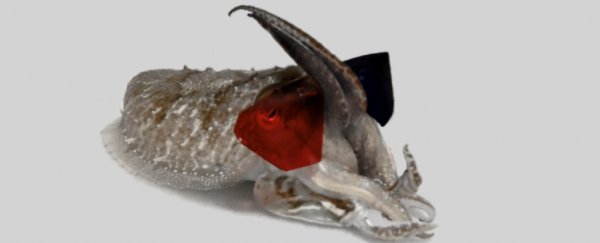Adorable cephalopods have been made even more adorable with tiny 3D glasses. But scientists weren't trying to get the cuttlefish to enjoy Jaws 3-D; rather, the stereoscopic red-and-blue eyewear is designed to help us understand how the animals' 3D vision works.
And, it turns out, even though the eyes of cuttlefish (Sepia officinalis) are quite different from human eyes, their 3D vision works a lot like ours - using what is called stereopsis to judge the distance to moving prey. But the mechanism behind that stereopsis is probably very different.
"This study takes us a step further toward understanding how different nervous systems have evolved to tackle the same problem," said neuroscientist Rachael Feord of the University of Cambridge in the UK.
Cuttlefish have some of the strangest eyes in the animal kingdom. They only have one type of photoreceptor, which should mean they can only see in black-and-white; but they have a unique, W-shaped pupil that may allow them to perceive colours in a completely different way from vertebrates.
When we focus our eyes, the shape of the lens changes. In cuttlefish, the lens actually changes position. And, unlike us, they have eyes that face in opposite directions, producing full 360-degree vision.
But cuttlefish also have eyes unlike other cephalopods, such as squids and octopuses, which can't swivel their eyes forward, and therefore can't rely on stereopsis for depth perception. This is when small differences between what each eye sees in the same view can be used to judge distance.
We know that some squids have bumps on their retinas that allow them to judge distance based on how quickly objects slip in and out of focus, for instance.
Unlike these relatives, cuttlefish can swivel their eyes to face forward. So researchers thought that cuttlefish might be different from other cephalopods, in that they had the ability to use stereopsis.
 (Wardill Lab)
(Wardill Lab)
To find out, they carefully superglued a small velcro patch between the eyes of 14 cuttlefish - this allowed for easy attachment and removal of the 3D glasses. (Three of the cuttlefish took the glasses off when they were returned to their tank.) They then trained the cuttlefish to strike at prey with their tentacles while wearing the glasses.
The tank was placed in front of a computer screen, and two walking shrimp of different colours were displayed. These shrimp images were made to appear either in front of or behind the screen through the 3D glasses. If the cuttlefish were using stereopsis, they would strike at this offset position.
And this is exactly what happened.
"How the cuttlefish reacted to the disparities clearly establishes that cuttlefish use stereopsis when hunting," said sensory neurobiologist Trevor Wardill of the University of Minnesota's College of Biological Sciences.
"When only one eye could see the shrimp, meaning stereopsis was not possible, the animals took longer to position themselves correctly. When both eyes could see the shrimp, meaning they utilised stereopsis, it allowed cuttlefish to make faster decisions when attacking. This can make all the difference in catching a meal."
This makes cuttlefish the second known invertebrate to use stereopsis to perceive distance. Scientists in the UK have shown that praying mantises also have binocular depth perception (a discovery also made with tiny 3D glasses).
But praying mantis stereopsis is very different from human stereopsis. We can perceive depth in still scenes, even when nothing is moving; praying mantis depth perception only focuses on things that are moving.
How cuttlefish stereopsis works isn't entirely clear, but it's likely to be a different procedure again - not because of their eyes, but rather their brains.
"While cuttlefish have similar eyes to humans, their brains are significantly different," said neuroscientist Paloma Gonzalez-Bellido of the College of Biological Sciences.
"We know that cuttlefish brains aren't segmented like humans. They do not seem to have a single part of the brain - like our occipital lobe - dedicated to processing vision. Our research shows there must be an area in their brain that compares the images from a cuttlefish's left and right eye and computes their differences."
The next step in the research is to investigate cuttlefish brain circuits to try and figure out exactly how the stereopsis computation works.
The research has been published in Science Advances.
